Wikipedia:Picture of the day/August 2014
|
Featured picture tools: |
These featured pictures, as scheduled below, appeared as the picture of the day (POTD) on the English Wikipedia's Main Page in August 2014. Individual sections for each day on this page can be linked to with the day number as the anchor name (e.g. [[Wikipedia:Picture of the day/August 2014#1]] for August 1).
You can add an automatically updating POTD template to your user page using {{Pic of the day}} (version with blurb) or {{POTD}} (version without blurb). For instructions on how to make custom POTD layouts, see Wikipedia:Picture of the day.Purge server cache
August 1

|
Portrait of a Young Girl is a small oil painting on oak panel completed between 1465 and 1470 by Petrus Christus. Unlike in prior Early Netherlandish paintings, the sitter is placed in an airy, three-dimensional, realistic setting. This portrait, described by art historian Joel Upton as "a polished pearl, almost opalescent, lying on a cushion of black velvet", was influential in the decades after its completion. Painting: Petrus Christus
Recently featured:
|
August 2
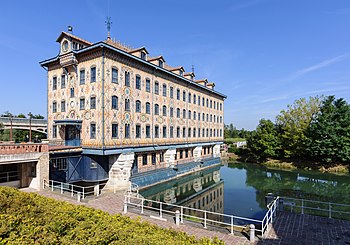
|
A chocolate factory designed by the architect Jules Saulnier for Menier Chocolate in Noisiel, France. Completed in 1872, it has been cited as the first true skeleton structure, with exterior walls needing only simple infill. The factory was designated by the government of France as an official Monument historique in 1992, and it is on the tentative list to be named a UNESCO World Heritage Site. Photograph: Myrabella
Recently featured:
|
August 3

|
The great-winged petrel (Pterodroma macroptera) is a species of petrel endemic to southern Australia and New Zealand; this specimen was photographed east of Tasmania. Two subspecies of the great-winged petrel are recognized. Photograph: JJ Harrison
Recently featured:
|
August 4

|
A mating pair of common Mormons. Females of this species are polymorphic, with three morphs, and may imitate the common rose or crimson rose. The female in this photograph, at the top of the coupling, is of the romulus morph. Photograph: Muhammad Mahdi Karim
Recently featured:
|
August 5
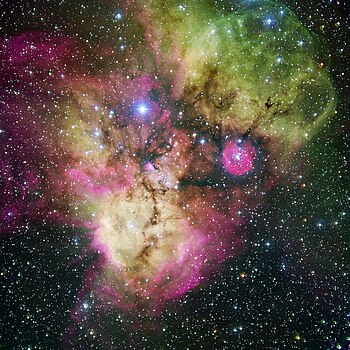
|
NGC 2467 is a star-forming region with a visual appearance often likened to a skull or a mandrill. Located in the southern constellation of Puppis, it contains the open clusters Haffner 18 (centre) and Haffner 19 (middle right: located inside the smaller pink "eye"), as well as vast areas of ionised gas. The bright star at the centre of the largest pink region is HD 64315, a massive young star that is helping to shape the whole nebular region's structure. Photograph: European Southern Observatory
Recently featured:
|
August 6
|
A NASA video, titled Curiosity's Seven Minutes of Terror, explaining the atmospheric entry, descent, and landing of the Mars rover Curiosity as part of the Mars Science Laboratory mission. The landing sequence required 6 vehicle configurations, 76 pyrotechnic devices, a large supersonic parachute, and more than 500,000 lines of computer code. (higher resolution) Video: NASA
Recently featured:
|
August 7
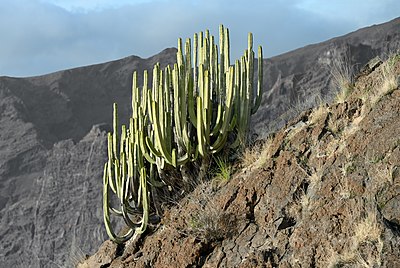
|
The Canary Island spurge (Euphorbia canariensis) is a succulent member of the genus Euphorbia endemic to the Canary Islands. It is a small tree which grows to between 3 and 4 metres (9.8 and 13.1 ft) in height and is made up of fleshy quadrangular or pentagonal trunks that look like cacti. This specimen was photographed close to the Mirador de Archipenque at Los Gigantes. Photograph: Claude Meisch
Recently featured:
|
August 8
|
A panoramic view of the main quadrangle of Stanford University, with Memorial Church in the center background, as seen from across the grass-covered Oval. Opened in 1891, this private research university was established by former California governor Leland Stanford and his wife, Jane, in memory of their only child. The 8,180-acre (3,310 ha) campus is located in what is now Silicon Valley, and the university's graduates include founders of Google, Yahoo!, and Hewlett-Packard. Photograph: King of Hearts
Recently featured:
|
August 9

|
A male myrtle warbler (Setophaga coronata coronata) in breeding plumage, photographed in the Léon-Provancher Ecological Reserve, Québec, Canada. This form, found in the northeastern United States and eastern Canada, is considered conspecific with the Audubon's warbler, which is found further west. The myrtle warbler can be distinguished from the Audubon's by its white eyestripe, white (not yellow) throat, and contrasting cheek patch. Photograph: Simon Pierre Barrette
Recently featured:
|
August 10
Subpage 1

|
Demand Notes are a type of United States paper money that were issued between August 1861 and April 1862 in denominations of 5, 10, and 20 U.S. dollars. Released during the American Civil War, these notes were used to pay expenses incurred by the Union during the war. They were popularly known as "greenbacks", a name inherited by their successors, the Legal Tender and Federal Reserve Notes. Shown here is a $5 note, dated 10 August 1861, which includes a portrait of the first Secretary of the Treasury, Alexander Hamilton, on the right, and the then-incomplete Statue of Freedom on the left. This bill is scanned from the National Numismatic Collection at the National Museum of American History.
Banknote: Bureau of Engraving and Printing (image courtesy of the National Numismatic Collection, National Museum of American History)
Recently featured:
|
Subpage 2
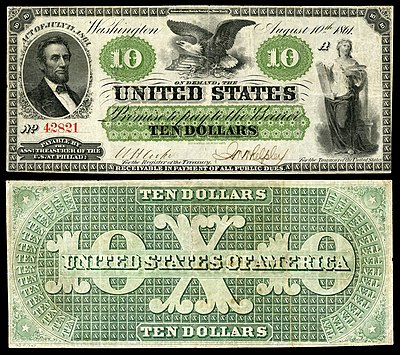
|
Demand Notes are a type of United States paper money that were issued between August 1861 and April 1862 in denominations of 5, 10, and 20 U.S. dollars. Released during the American Civil War, these notes were used to pay expenses incurred by the Union during the war. They were popularly known as "greenbacks", a name inherited by their successors, the Legal Tender and Federal Reserve Notes. Shown here is a $10 note, dated 10 August 1861, which includes an allegorical image of art on the right, and President Abraham Lincoln on the left; in the top center of the note is a vignette of a Bald Eagle perched on olive branches with a ribbon stating E PLURIBUS UNUM. This bill is scanned from the National Numismatic Collection at the National Museum of American History.
Banknote: Bureau of Engraving and Printing (image courtesy of the National Numismatic Collection, National Museum of American History)
Recently featured:
|
Subpage 3
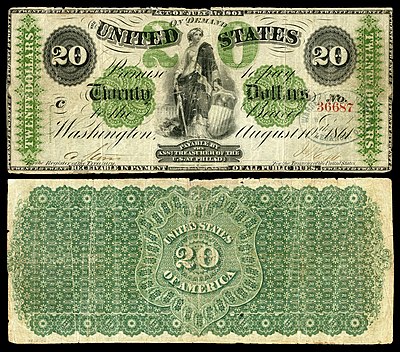
|
Demand Notes are a type of United States paper money that were issued between August 1861 and April 1862 in denominations of 5, 10, and 20 U.S. dollars. Released during the American Civil War, these notes were used to pay expenses incurred by the Union during the war. They were popularly known as "greenbacks", a name inherited by their successors, the Legal Tender and Federal Reserve Notes. Shown here is a $20 note, dated 10 August 1861, which features a feminine allegory representing either Liberty, or perhaps America, in the center. The figure has a sword in her right hand and holds a striped shield, featuring a Bald Eagle at the top, in her left. This bill is scanned from the National Numismatic Collection at the National Museum of American History.
Banknote: Bureau of Engraving and Printing (image courtesy of the National Numismatic Collection, National Museum of American History)
Recently featured:
|
August 11
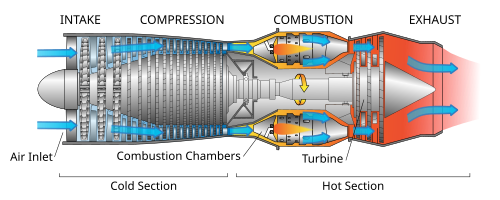
|
|
A diagram of a typical turbojet engine. Air is compressed as it enters the engine, and is mixed with fuel that burns in the combustion section. Released through the exhaust, the resulting hot gases provide forward thrust and turn the turbines that drive the fan blades of the compressor. Diagram: Jeff Dahl
Recently featured:
|
August 12
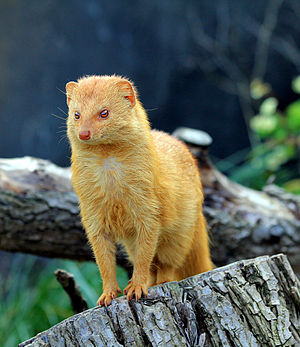
|
The slender mongoose (Galerella sanguinea) is a common species of mongoose found throughout much of sub-Saharan Africa. Dozens of subspecies are known, and the fur color varies between subspecies. The slender mongoose tends to live alone or in pairs, and, although it is an opportunistic omnivore, it feeds primarily on insects. This specimen was photographed at the Prague Zoo in the Czech Republic. Photo: Karel Jakubec
Recently featured:
|
August 13
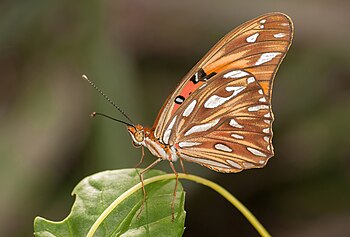
|
The Gulf fritillary (Agraulis vanillae) is a bright orange butterfly of the family Nymphalidae and subfamily Heliconiinae, found from Argentina in the south to California in the north. Photograph: Wilfredor
Recently featured:
|
August 14
|
A panoramic view of the Ducal Palace of Vila Viçosa, in the Portuguese Alentejo. For centuries it was the seat of the House of Braganza, one of the most important noble houses in Portugal and the kingdom's ruling house from 1640 until a republican government replaced King Manuel II in the 5 October 1910 revolution. Photograph: Alvesgaspar
Recently featured:
|
August 15

|
The harlequin beetle (Acrocinus longimanus) is a large tropical longhorn beetle native to the Americas. The species' common name is derived from the elaborate pattern of black, red and greenish yellow markings on the wing covers of both sexes. Photograph: Didier Descouens
Recently featured:
|
August 16
|
A panoramic view of Schloss Weißenstein, a palatial residence in Pommersfelden, Bavaria. Designed for Lothar Franz von Schönborn and built between 1711 and 1718, it remains in the Schönborn family. The castle contains a large Baroque art collection. Photograph: User:Rainer Lippert
Recently featured:
|
August 17

|
An 1801 map of the East Indies, prepared by John Cary for his New Universal Atlas, depicting all of Southeast Asia. In a restricted sense, the term East Indies refers to the area's islands, though it has also been used to include certain land-locked areas (mostly those under Indian cultural influence). European powers, beginning with the Portuguese, explored and colonized these regions in the late 15th century; the East Indies were not decolonized until the 20th century. Map: John Cary
Recently featured:
|
August 18

|
A male Australian shelduck (Tadorna tadornoides) in Perth, Western Australia. First described in 1828, this species of shelduck is sexually dimorphic: males are larger than females and do not have a white ring around their eyes. Photo: JJ Harrison
Recently featured:
|
August 19

|
Charles Bolden (b. 1946) is the current Administrator of NASA. After graduating from the United States Naval Academy in 1968, Bolden became a pilot for the Marine Corps, seeing combat during the Vietnam War. He spent time as a test pilot during the 1970s before being selected in 1980 for the astronaut program. During his time as an astronaut he spent more than 28 days in space, taking part in four missions. After leaving NASA, he returned to the military and reached the rank of Major General before retiring in 2004. He was selected by American president Barack Obama to head NASA in 2009, becoming the first African American to head the agency on a permanent basis. Photo: NASA/Bill Ingalls
Recently featured:
|
August 20

|
Benjamin Harrison (1833–1901) was a politician who became the 23rd president of the United States. The grandson of former president William Henry Harrison, Benjamin Harrison was a lawyer and soldier before becoming a U.S. senator from Indiana. After defeating the incumbent Grover Cleveland, in 1889 Harrison became president; during his four-year term he enacted such policies as the McKinley Tariff and the Sherman Antitrust Act. Photo: Pach Brothers, restoration: Adam Cuerden
Recently featured:
|
August 21

|
|
Osaka Castle is a castle in Chūō-ku, Osaka, Japan. Built from 1583 to 1597 by Toyotomi Hideyoshi, it played a major role in the unification of Japan during the sixteenth century of the Azuchi–Momoyama period. After Toyotomi died in 1598, control of the castle went to his young son, Hideyori, who was deposed by Tokugawa Ieyasu eighteen years later after a series of sieges. In 1868 the castle, still under control of the Tokugawa shogunate, fell to pro-imperial forces. Since then the castle has been rebuilt several times, most recently in the 1990s. Photo: 663highland
Recently featured:
|
August 22

|
|
A diagram of a typical thermal power station, a type of power plant in which the prime mover is steam driven. Water is heated, turns into steam and spins a steam turbine, which drives an electrical generator. After it passes through the turbine, the steam is condensed in a condenser and recycled to where it was heated; this is known as a Rankine cycle. For a more detailed overview of the process, consult the diagram's description. Diagram: BillC; modifications: MaCRoEco
Recently featured:
|
August 23
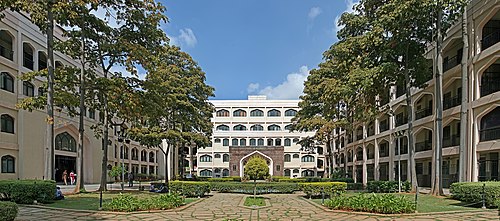
|
|
Al-Ameen College of Pharmacy is a pharmacy college in Bangalore, India. Established in 1983, it is under the purview of the Al-Ameen Educational Society. Photo: Muhammad Mahdi Karim
Recently featured:
|
August 24

|
The reverse of a 1933-dated specimen of the double eagle ($20 gold piece) designed by Augustus Saint-Gaudens. 445,500 specimens were minted with this date, but after the Gold Reserve Act withdrew the legal tender status of gold coins and outlawed most private possession of gold, almost all were destroyed. Only two double eagles were intentionally spared; they are in the National Numismatic Collection of the National Museum of American History. But at least twenty more were stolen by an unidentified person. Of these, nine were melted down in the 1940s and 50s and ten more are held at Fort Knox. Another, which had belonged to King Farouk of Egypt, was recovered in 1996 and sold at auction in 2002 to an anonymous bidder for almost 7.6 million dollars. Coin: Augustus Saint-Gaudens; photo: United States Mint
Recently featured:
|
August 25
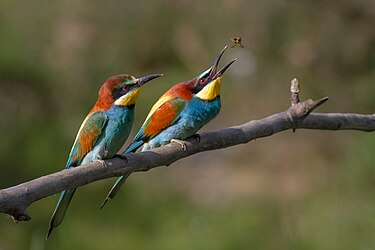
|
The European bee-eater (Merops apiaster) is a near passerine bird in the bee-eater family Meropidae which breeds in southern Europe and in parts of north Africa and western Asia and winters in tropical Africa, India and Sri Lanka. The species predominantly feeds on insects, especially bees, wasps and hornets, which are caught in the air by sorties from an open perch. Photo: Pierre Dalous
Recently featured:
|
August 26
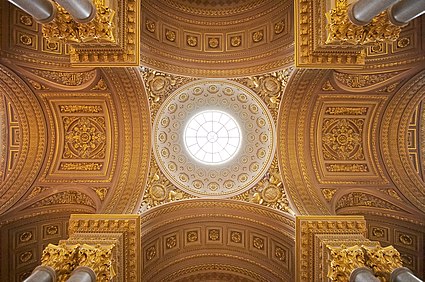
|
|
The central part of the ceiling at the Galerie des Batailles, a 120-by-13-metre (394 by 43 ft) gallery at the Palace of Versailles joining onto the grand and petit appartements de la reine. Designed by Pierre-François-Léonard Fontaine and Frédéric Nepveu upon the order of Louis Philippe I, the gallery's design includes a wide cornice supporting a coffered painted ceiling with entablatures supported by Corinthian columns along the length of the gallery. Photo: -donald-
Recently featured:
|
August 27

|
Leiocephalus personatus is a species of curly-tailed lizard first described by Edward Drinker Cope in 1862. This specimen was photographed in the reptile zoo of Neu-Ulm, Germany. Photo: H. Krisp
Recently featured:
|
August 28
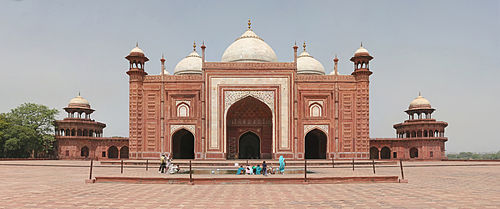
|
|
The mosque at the Taj Mahal complex in Agra, India. This red sandstone building, on the western side of the complex, faces the west side of the mausoleum. In the forefront is a howz, meant for ablution. On the eastern side of the complex is the jawab ("answer"), a mirror image of the mosque except for the missing mihrab and different floor pattern; this jawab was mainly intended for architectural balance. Both were constructed in 1643. Photo: Muhammad Mahdi Karim
Recently featured:
|
August 29

|
Spialia mafa is a species of butterfly in the spread-winged skipper subfamily that is found in south-western Africa. These skippers bask with their wings held wide open, but close the wings when at rest. The subfamily consists of seven tribes, a number which has increased in the past several decades as more tribes were recognized. Photo: Muhammad Mahdi Karim
Recently featured:
|
August 30

|
A two-point equidistant projection of Eurasia. All distances of other points from the two points marked in red (45°N 40°E and 30°N 110°E) are correct. This map is a derivative of NASA's Blue Marble summer month composite, with oceans lightened to enhance legibility and contrast. Map: Strebe, using the Geocart map projection software
Recently featured:
|
August 31

|
|
This image represents a view from the "front" of the neural system of a giant scallop, slightly turned, with the shell or "valve" hinge line at the top and open free margin along the bottom (this image shows what most observers might think of as a "side view" or "edge view"— see inset for orientation). The largest, most important ganglia are the parietovisceral (not the cerebral) which connect to the circumpallial nerve somewhat like an axle connects via spokes to the rim of a wheel. The circumpallial nerve forms a complete folded double ring around the edge of the animal's disk-like mantle inside each valve (mantle not shown here). The hundreds of nerves of the scallop's eyes and tentacles would have appeared as long thin lines jutting off along the entire length of this nerve like hazy fringe. Diagram: K.D. Schroeder
Recently featured:
|
Picture of the day archives and future dates



